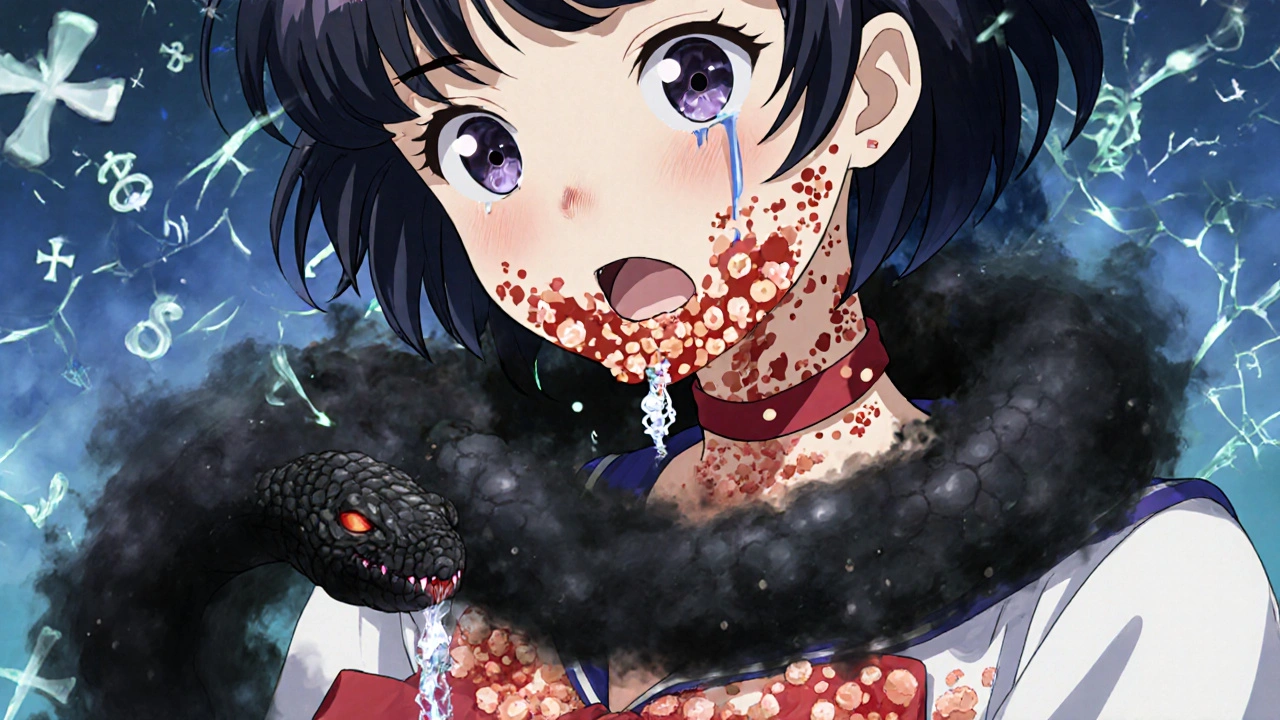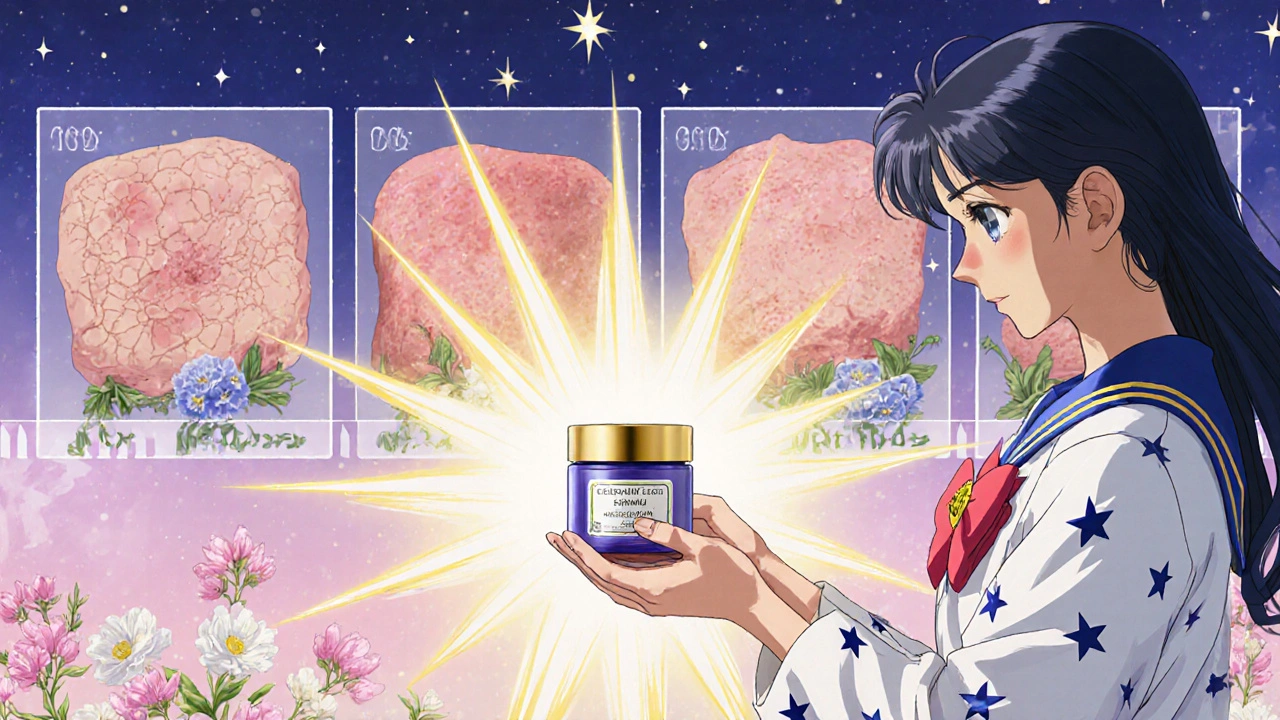Topical Steroid Risk Assessment Tool
Calculate Your Risk
This tool helps you understand your risk of skin atrophy and infection based on your topical steroid use patterns.
Risk Level: -
Risk Description: -
Recommendations: -
When you have eczema, psoriasis, or a stubborn rash, a topical corticosteroid cream can feel like a miracle. It calms the redness, stops the itching, and gives you back some control over your skin. But what happens when that miracle starts to backfire? Over time, especially with strong steroids used too long or on sensitive skin, your skin doesn’t just heal-it begins to break down. Thinning. Stretching. Becoming fragile. And worse, it becomes a breeding ground for infections you didn’t even know you were at risk for.
How Topical Steroids Thin Your Skin
Topical corticosteroids work by suppressing inflammation, but they don’t just target the bad cells. They also slow down the natural life cycle of your skin. Your epidermis-the top layer-and your dermis-the layer beneath-start to lose structure. Collagen, the protein that gives skin its strength and bounce, stops being made at normal rates. Fibroblasts, the cells that produce collagen, get quieter. Keratinocytes, the skin’s building blocks, stop multiplying as they should. This isn’t a slow fade. Even three days of using a potent steroid on your face can change how your skin behaves. The stratum corneum, the outermost protective barrier, gets thinner. Ceramides, cholesterol, and fatty acids-the lipids that hold your skin cells together like mortar-drop sharply. That’s why your skin feels tight, dry, and sensitive, even when it doesn’t look bad yet. Transepidermal water loss (TEWL) spikes, meaning your skin can’t hold onto moisture. It’s like removing the bricks from a wall-you don’t see the hole right away, but the structure is weakening. The damage becomes visible as skin atrophy: fine lines that look like wrinkles, but aren’t caused by aging. Doctors call them "elephant wrinkles"-deep, crinkled folds that don’t smooth out. You might notice your skin looks translucent, especially on the face or inner arms. Veins become more visible. Bruises appear with little or no trauma. These aren’t just cosmetic. They’re signs your skin’s defense system is failing.Why Infections Follow
When your skin barrier is broken, germs don’t need much of an invitation. Fungi, bacteria, and viruses move in fast. The most common infections linked to long-term steroid use are:- Fungal infections-especially candidiasis, which shows up as red, scaly patches with tiny pustules around the edges. It often hides in skin folds-under the breasts, in the groin, or around the mouth (perioral dermatitis).
- Bacterial infections-Staphylococcus aureus thrives on compromised skin. It can cause impetigo, folliculitis, or even deeper abscesses.
- Viral infections-Herpes simplex can flare into widespread, painful sores (eczema herpeticum), especially if steroids mask the early warning signs.
Who’s Most at Risk
Not everyone who uses topical steroids gets these problems-but some people are far more vulnerable.- Face, groin, armpits, and eyelids-These areas have thinner skin. Even low-potency steroids can cause atrophy here. That’s why many doctors avoid prescribing strong steroids for the face unless absolutely necessary.
- Children-Their skin is naturally more absorbent. A cream that’s safe for an adult can cause serious atrophy in a toddler.
- Long-term users-Using a potent steroid (Class I-IV) for more than two weeks raises the risk dramatically. Studies show about 17% of long-term users develop visible atrophy.
- People using over-the-counter steroids-Many creams sold as "hydrocortisone" are labeled as mild, but some contain hidden stronger steroids. In New Zealand and the U.S., regulators have cracked down, but unregulated products still appear online.

The Withdrawal Trap
Stopping steroids suddenly after months or years of use doesn’t just bring back the original rash-it often makes it worse. This is called Topical Steroid Withdrawal (TSW), or "red skin syndrome." The pattern is chillingly consistent:- One week after stopping: intense burning, stinging, redness-even if the skin looked healed before.
- Two weeks later: flares come and go, with peeling and oozing.
- Each flare gets shorter, but the recovery periods get longer.
- For some, it takes 6 to 12 months to stabilize. In rare cases, it lasts years.
How to Prevent and Reverse the Damage
The best treatment for steroid-induced skin damage is prevention-and if damage has already happened, the only path forward is to stop using steroids, carefully.- Use the weakest steroid possible. Start with Class V-VII (mild) unless your doctor specifically says you need stronger. Never use Class I-IV on your face unless under strict supervision.
- Limit duration. For potent steroids, no more than 2-4 weeks on any one area. For the face, aim for under 7 days.
- Apply only to active areas. Don’t spread it over large areas or use it daily as a moisturizer.
- Never use OTC steroids without checking the active ingredient. Some products sold as "hydrocortisone 1%" contain stronger steroids like clobetasol.
- Stop the steroid. But don’t quit cold turkey if you’ve used it for more than two weeks. Work with a dermatologist to taper slowly.
- Repair your barrier. Use moisturizers with ceramides, cholesterol, and free fatty acids in a 3:1:1 ratio. Studies show this combination improves skin barrier function by 68% in eight weeks.
- Protect from the sun. UV rays break down collagen even faster in atrophic skin. Use SPF 50+ daily-even on cloudy days. One study showed SPF 50 reduced collagen loss by 42% in damaged skin.
- Treat infections directly. If you have red, scaly patches with pustules, see a dermatologist. Antifungals like clotrimazole or oral antibiotics may be needed. Don’t try to treat this with more steroids.

What’s Changing in Treatment
The medical world is waking up. The FDA and EMA now require warning labels on all topical steroid packaging. In New Zealand, Medsafe issued guidance in 2004 warning about skin atrophy from inhaled steroids-a reminder that these effects aren’t just skin-deep. New treatments are on the horizon. Researchers are testing "dual-soft" glucocorticoid agonists that fight inflammation without shutting down collagen production. The NIH is running trials on a formula that combines low-dose steroids with fibroblast growth factor to rebuild skin structure. Early results show a 63% drop in atrophy compared to standard therapy. The market for steroid-sparing treatments-like calcineurin inhibitors (tacrolimus, pimecrolimus), PDE4 inhibitors (crisaborole), and JAK inhibitors-is growing fast. By 2028, it’s expected to hit $3.8 billion globally. That’s not just business-it’s a sign that safer options are becoming essential.What You Should Do Now
If you’re using a topical steroid:- Ask yourself: Is this still necessary? Has my skin improved enough to stop?
- Check the strength. Is it Class I-IV? If so, and you’ve used it on your face for more than a week, talk to your doctor.
- Look for signs: thinning skin, visible veins, stretch marks, persistent redness, or burning without visible rash.
- Start using a ceramide-based moisturizer-even if you’re still using steroids.
- Wear sunscreen every day.
- You’re not alone. Thousands are going through this.
- Don’t restart steroids out of fear. It only delays recovery.
- Focus on barrier repair, hydration, and patience. Recovery takes time, but it happens.
- Find a dermatologist who understands TSW. Not all do-but enough do now to make a difference.

Marcia Martins
October 27, 2025 AT 22:22Yikes. I had no idea using hydrocortisone for my eczema could do this much damage. I’ve been using it for months on my arms and now my skin feels like tissue paper. 😔 Thanks for laying this out so clearly.
Rachel Harrison
October 29, 2025 AT 09:47Barriers don’t fix themselves overnight. I started using CeraVe PM with ceramides after my dermatologist warned me about steroid thinning. Six weeks in? My skin actually stopped feeling like sandpaper. 🙌 Don’t skip the moisturizer.
Kevin McAllister
October 31, 2025 AT 09:13Let’s be real-this isn’t a medical issue, it’s a cultural one. We’ve been conditioned to swallow pills and slap creams on problems without asking why they exist. The body isn’t a machine to be suppressed-it’s a system to be understood. You don’t fix inflammation with steroids-you fix it by fixing your diet, your stress, your sleep. But no one wants to hear that. It’s easier to blame the skin than the lifestyle.
And now we have a generation of people with translucent faces because they were told to ‘just keep using it.’ That’s not healthcare. That’s corporate negligence wrapped in a white coat. The FDA’s warning labels? Too little, too late. And don’t get me started on OTC products with hidden clobetasol-those are crimes against biology.
People think ‘natural’ means ‘ineffective.’ But the truth? The body heals faster without chemical suppression. I went cold turkey after two years of steroid abuse. Sixteen months of burning, peeling, insomnia. But now? My skin breathes. It’s not perfect-but it’s mine. And I didn’t buy it from a pharmacy.
Stop treating symptoms. Start treating roots. The cream isn’t the cure. The cure is awareness.
Sue M
November 1, 2025 AT 12:54Actually, the term is 'topical steroid withdrawal,' not 'red skin syndrome.' The latter is an informal, non-clinical phrase that lacks precision and undermines the legitimacy of the condition. Please use accurate terminology when discussing medical phenomena.
james landon
November 2, 2025 AT 07:15Bro I used steroid cream on my face for a year because my acne was ‘so bad’… now my skin looks like a crumpled paper bag. And I’m still scared to stop. 😭 Any tips? I need help.
Tiffanie Doyle
November 2, 2025 AT 14:41you’re not alone james!! i went through the same thing-burning all night, no makeup, no sun, no peace. but i started doing oil cleansing with jojoba + ceramide cream and honestly? it’s slow but it’s working. you got this. 💪❤️
Jenn Clark
November 3, 2025 AT 17:15My mom used steroid cream on my baby brother’s diaper rash for three weeks. He developed these deep wrinkles under his thighs. We didn’t know why. Now I know. This post should be mandatory reading for every new parent.
giri pranata
November 4, 2025 AT 06:24From India, where OTC steroid creams are sold like candy at every corner store. I’ve seen grandmas apply clobetasol to their grandchildren’s faces for ‘fair skin.’ No one knows the risks. This article needs to go viral here. Thank you for writing this.
L Walker
November 6, 2025 AT 06:14Interesting how the UK’s NICE guidelines still don’t explicitly warn against facial use beyond 7 days. Meanwhile, the US has clearer warnings but worse OTC regulation. Global inconsistency is dangerous. We need unified standards-not patchwork policies.
Robert Bowser
November 7, 2025 AT 21:43Thank you for this. I’ve been avoiding dermatologists because I was scared they’d just give me more cream. But reading this made me realize I need to find one who gets it. Not all of them do-but I’m going to try.